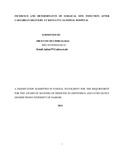| dc.contributor.author | Kabau, David Muchiri | |
| dc.date.accessioned | 2015-08-27T06:24:52Z | |
| dc.date.available | 2015-08-27T06:24:52Z | |
| dc.date.issued | 2014 | |
| dc.identifier.citation | Masters of Medicine degree in Obstetrics and Gynaecology | en_US |
| dc.identifier.uri | http://hdl.handle.net/11295/90154 | |
| dc.description.abstract | Background: Caesarean delivery is one of the commonest operations worldwide. Caesarean
delivery carries a risk of infection 5 to 20 times that of normal delivery. It is the single most
important risk factor for postpartum maternal infection. Infection/sepsis is the second single
leading cause of maternal mortality in Africa after hemorrhage contributing to 10 % of maternal
mortality. Establishing the burden of SSI and its determinants is important in instituting specific
measures to control SSI.
Study objectives: This study aimed to determine the cumulative incidence and determinants of
post caesarean surgical site infections at Kenyatta National hospital.
Methods
Design: A prospective cohort study where women who had caesarean delivery at Kenyatta
National Hospital during the study period were followed up for duration of thirty days to determine
the incidence of SSI at three days, fourteen days and thirty days after caesarean delivery. A total
of two hundred women who had caesarean delivery were recruited.
Study procedures: Data was collected using an interviewer administered questionnaire. The
questionnaire was filled on the third postoperative day and at two weeks post natal review. A final
telephone interview was done at 30 days post-operative. Socio-demographic data, antenatal details,
details on any comorbidities and operation details were obtained on the third post-operative day.
The surgical sites were inspected on the third day and two weeks post-operative.
Data analysis: Data collected were cleaned, coded and entered into Epi data package and were
later transferred to Statistical Package for Social Sciences (SPSS) version 20 for analysis.
Descriptive statistics were be used. Graphs and tables were used to summarize data. Odd’s ratios,
95% confidence intervals and p value set at 0.05 was used to determine statistical significance of
the associations between independent variables and risk of surgical site infection.
Results. A total of 184 participants were followed up for 30 days. Sixteen were lost to follow up.
The mean age of the participants was 27.43 years (SD-5.652) with a range of 16 to 46 years. The
incidence of SSI was 1.63% at 3 days, 20.7% at two weeks and 0% at 30 days with a cumulative
incidence of 22.3% at 30 days. Majority of the infections were superficial incisional CDC 1 (90.2
% (n=37)) and most of the infections developed after discharge (93 %). There were four deep
incisional SSIs (CDC 2). None of the patients developed an organ space infection and there were
no deaths. All the SSI that developed after discharge did so within two weeks post caesarean
section. Significant association was found between prolonged labour and development of SSI
(p=0.01) and presence of ruptured membranes (p=0.013).No significant association was noted with
anemia, HIV status, duration of surgery or timing of administration of antibiotics.
Conclusion: The incidence of SSI at KNH was found to be high with one in five women
undergoing caesarean delivery developing a SSI. Prolonged labour was found to be significantly
associated with risk of developing SSI. Use of appropriate tools to prevent prolonged labour should
be enforced. Routine amniotomy should also be discouraged. | en_US |
| dc.language.iso | en | en_US |
| dc.publisher | University of Nairobi | en_US |
| dc.title | Incidence and determinants of surgical site infection after caesarean delivery at Kenyatta national hospital | en_US |
| dc.type | Thesis | en_US |
| dc.description.department | a
Department of Psychiatry, University of Nairobi, ; bDepartment of Mental Health, School of Medicine,
Moi University, Eldoret, Kenya | |
| dc.type.material | en_US | en_US |

